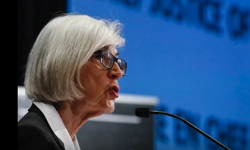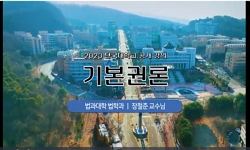As a result of the MeToo movement in each level of society, issues related to sex that have not even been superficially dealt with until now are actively being discussed, and there is a growing voice that regulations on sexual harassment should be str...
http://chineseinput.net/에서 pinyin(병음)방식으로 중국어를 변환할 수 있습니다.
변환된 중국어를 복사하여 사용하시면 됩니다.
- 中文 을 입력하시려면 zhongwen을 입력하시고 space를누르시면됩니다.
- 北京 을 입력하시려면 beijing을 입력하시고 space를 누르시면 됩니다.

성희롱의 법적 규제와 성적 표현의 자유의 관계에 대한 소고 = A Study on the Relationship between Legal Regulations on Sexual Harassment and Freedom of Sexual Expression
한글로보기https://www.riss.kr/link?id=A107798936
- 저자
- 발행기관
- 학술지명
- 권호사항
-
발행연도
2021
-
작성언어
-
- 주제어
-
KDC
300
-
등재정보
KCI등재
-
자료형태
학술저널
-
수록면
93-119(27쪽)
-
KCI 피인용횟수
0
- DOI식별코드
- 제공처
- 소장기관
-
0
상세조회 -
0
다운로드
부가정보
다국어 초록 (Multilingual Abstract)
Generally, sexual harassment refers to an act that makes the other person feel sexual shame or humiliation with unwanted sexual words and actions. Our law does not have a criminal provision for sexual harassment, but it allows for a specific penalty clause, so I agree there is a need for social efforts to eradicate sexual harassment. However, there is a problem in prescribing sexual harassment as sexual violence by adding criminal legal sanctions in addition to the existing law that regulates sexual harassment. Sexual harassment and sexual violence are distinctly different. Therefore, it is reasonable to apply different laws to sexual harassment and sexual violence, which are different in terms of crime, according to the severity of crime. But sexual harassment cannot exist as objective standards as sexual violence punished in criminal law.
Therefore, it is a way to protect the freedom of sexual expression guaranteed by the Constitution to apply the crime of sexual harassment in accordance with existing precedent, but treating as a misdemeanor crimes causing fatal damage to individuals for a lengthy period of time or excessively, in order to avoid the abuse of criminal punishment and State Power.
As a result of the MeToo movement in each level of society, issues related to sex that have not even been superficially dealt with until now are actively being discussed, and there is a growing voice that regulations on sexual harassment should be strengthened. Some argue that not only physical violence, but also verbal abuse that causes mental damage. should be considered as sexual harassment.
Generally, sexual harassment refers to an act that makes the other person feel sexual shame or humiliation with unwanted sexual words and actions. Our law does not have a criminal provision for sexual harassment, but it allows for a specific penalty clause, so I agree there is a need for social efforts to eradicate sexual harassment. However, there is a problem in prescribing sexual harassment as sexual violence by adding criminal legal sanctions in addition to the existing law that regulates sexual harassment. Sexual harassment and sexual violence are distinctly different. Therefore, it is reasonable to apply different laws to sexual harassment and sexual violence, which are different in terms of crime, according to the severity of crime. But sexual harassment cannot exist as objective standards as sexual violence punished in criminal law.
Therefore, it is a way to protect the freedom of sexual expression guaranteed by the Constitution to apply the crime of sexual harassment in accordance with existing precedent, but treating as a misdemeanor crimes causing fatal damage to individuals for a lengthy period of time or excessively, in order to avoid the abuse of criminal punishment and State Power.
참고문헌 (Reference)
1 김덕호, "현대 미국의 사회운동" 비봉출판사 2001
2 한수웅, "헌법학" 법문사 2021
3 성낙인, "헌법학" 법문사 2021
4 "헌법재판소 2021. 1. 28. 선고 2018헌마456 등 결정"
5 "헌법재판소 2010. 12. 28. 선고 2008헌바157 등 결정"
6 "헌법재판소 2002. 6. 27. 선고 99헌마480 결정"
7 "헌법재판소 2002. 4. 25. 선고 2001헌가27 결정"
8 양건, "헌법강의" 법문사 2020
9 허영, "한국헌법론" 박영사 2020
10 전광석, "한국헌법론" 집현재 2021
1 김덕호, "현대 미국의 사회운동" 비봉출판사 2001
2 한수웅, "헌법학" 법문사 2021
3 성낙인, "헌법학" 법문사 2021
4 "헌법재판소 2021. 1. 28. 선고 2018헌마456 등 결정"
5 "헌법재판소 2010. 12. 28. 선고 2008헌바157 등 결정"
6 "헌법재판소 2002. 6. 27. 선고 99헌마480 결정"
7 "헌법재판소 2002. 4. 25. 선고 2001헌가27 결정"
8 양건, "헌법강의" 법문사 2020
9 허영, "한국헌법론" 박영사 2020
10 전광석, "한국헌법론" 집현재 2021
11 한희정, "한국사회의 성희롱 개념 연구: 국내학술지를 중심으로" 이화사회과학원 31 (31): 87-128, 2015
12 "한겨레"
13 차선자, "표현의 자유와 성희롱 - 대상이 특정되지 않은 성적언동을 중심으로 -" 법학연구소 35 (35): 279-313, 2015
14 박선영, "직장 내 성희롱 성폭력 사건처리 매뉴얼"
15 조재현, "언론의 자유의 보호영역과 음란의 개념" 고시계사 2010
16 김엘림, "성희롱의 법적 개념의 형성과 변화" 한국젠더법학회 6 (6): 2015
17 국가인권위원회, "성희롱에 대한 국민의식 조사 연구보고서" 국가인권위원회 2020
18 김정아, "성희롱 인식, 자아존중감, 성역할 고정관념이 성희롱 대처방식에 미치는 영향" 한국비서학회 28 (28): 91-111, 2019
19 서영주, "성희롱 관련법에 대한 고찰" 강원대학교 비교법학연구소 14 : 2001
20 이인호, "성표현의 자유와 한계" (사)한국언론법학회 7 (7): 1-45, 2008
21 이희훈, "성적 자기결정권과 성폭력 관련 법제 및 판례에 대한 헌법적 고찰" 헌법재판소 26 : 175-239, 2015
22 "법률신문"
23 홍완식, "법과 사회" 법문사 2021
24 "대법원 2018. 4. 12. 선고 2017두74702 판결"
25 "대법원 2005. 7. 22. 선고 2003도2911 판결"
26 "대법원 1998. 2. 10. 선고 95다39533 판결"
27 "뉴스1"
28 김엘림, "남녀평등과 법" 한국방송통신대학교 출판문화원 2016
29 국가인권위원회, "국가인권위원회 진정사건 백서" 국가인권위원회 2012
30 "국가법령정보센터"
31 "경향신문"
32 최희경, "美聯邦大法院의 性戱弄判決에 대한 硏究" 법학연구소 16 (16): 201-223, 2011
33 金尚均, "ヘイト スピーチの法的研究" 法律文化社 2014
34 이동연, "‘표현의 자유’를 다시 생각한다" 문화과학사 2009
35 "Wisconsin v. Mitchell, 508 U.S. 476 (1993)"
36 "DAUM"
동일학술지(권/호) 다른 논문
-
- 연세대학교 법학연구원
- 박동진 ( Park Dong Jin )
- 2021
- KCI등재
-
국민참여재판의 배제제도에 관한 고찰 ― 일본의 재판원재판제도와 관련하여 ―
- 연세대학교 법학연구원
- 이진수 ( Lee Jin-soo )
- 2021
- KCI등재
-
개정 주택임대차보호법의 문제점 검토 ― 계약갱신요구권과 전월세인상률 상한제의 한계를 중심으로 ―
- 연세대학교 법학연구원
- 권오상 ( Kwon Oh-sang )
- 2021
- KCI등재
-
변호사의 지위와 신의성실의 원칙 등에 의한 보수 감액 여부 ― 대법원 2018.5.17. 선고 2016다35833 전원합의체 판결 ―
- 연세대학교 법학연구원
- 장창민 ( Jang Changmin )
- 2021
- KCI등재
분석정보
인용정보 인용지수 설명보기
학술지 이력
| 연월일 | 이력구분 | 이력상세 | 등재구분 |
|---|---|---|---|
| 2027 | 평가예정 | 재인증평가 신청대상 (재인증) | |
| 2021-01-01 | 평가 | 등재학술지 유지 (재인증) |  |
| 2018-01-01 | 평가 | 등재학술지 유지 (등재유지) |  |
| 2015-01-01 | 평가 | 등재학술지 선정 (계속평가) |  |
| 2013-01-01 | 평가 | 등재후보학술지 유지 (기타) |  |
| 2012-01-01 | 평가 | 등재후보학술지 유지 (기타) |  |
| 2011-01-01 | 평가 | 등재후보학술지 유지 (등재후보2차) |  |
| 2009-06-18 | 학회명변경 | 한글명 : 법학연구소 -> 법학연구원 |  |
| 2009-01-01 | 평가 | 등재후보 1차 PASS (등재후보1차) |  |
| 2007-01-01 | 평가 | 등재후보학술지 선정 (신규평가) |  |
학술지 인용정보
| 기준연도 | WOS-KCI 통합IF(2년) | KCIF(2년) | KCIF(3년) |
|---|---|---|---|
| 2016 | 0.8 | 0.8 | 0.78 |
| KCIF(4년) | KCIF(5년) | 중심성지수(3년) | 즉시성지수 |
| 0.66 | 0.71 | 0.893 | 0.18 |




 KISS
KISS







